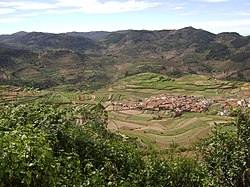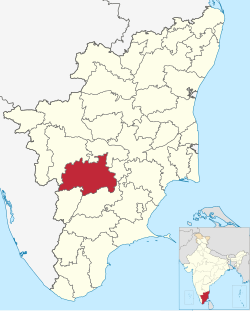Top Qs
Timeline
Chat
Perspective
Dindigul district
District of Tamil Nadu in India From Wikipedia, the free encyclopedia
Remove ads
Dindigul District is one of the 38 districts in the state of Tamil Nadu in India. Dindigul District is the largest district in Tamil Nadu by area. The district was carved out of Madurai District in 1985. It has an area of 6266.64 km2 and comprises 3 revenue divisions, 10 taluks, and 14 panchayat unions. The district is located in Southwest of Tamil Nadu. The district is bound by Madurai district in the south,Tiruppur district in the northwest, Karur district in the north, Tiruchirappalli district in the northeast, Theni district in the Southwest and Idukki district of Kerala to the west. As of 2011, the district had a population of 2,159,775 with a sex-ratio of 998 females for every 1,000 males.
Remove ads
Economy
Summarize
Perspective

According to Indian Census of 2001, Dindigul City's urban workforce participation rate is 35.24 percent. Dindigul, being the headquarters of the district, has registered growth in the secondary and tertiary sectors, with a corresponding decrease in the primary Sector. Major employment in the city is provided by industrial estates, hand loom, trading and commerce activities. Approximately 90 percent of the workforce is employed in the tertiary sector. The district at large has only two industrial estates, with one of them located in the city. Oddanchatram is one of the important towns in Dindigul district. Oddanchatram Vegetable Market (also known as Gandhi market Archived 12 August 2019 at the Wayback Machine) is the largest vegetable market in Tamil Nadu. As of 2001, there were approximately 60 tanneries, 165 lock manufacturing units and large number of cotton spinning mills.[4]
Locks and steel safes are manufactured in Dindigul and operated as a co-operative sector. Locks manufactured in Dindigul are sold in national and international markets and it is well known all over India for the quality of locks.[5] Dindigul locks received geographical indication on 30 August 2019.[6] A decline in lock industry is observed in modern times and other industries like leather, handloom, and aggro opportunities have gained significance. Silk, muslin and blanket manufacturing is common in Dindigul and after Coimbatore, the city has the second largest textile spindling capacity in the State. Chinnalapatti silk, a brand of silk saree is produced out of Chinnalapatti located 11 km (6.8 mi) from the city.[7] The climate condition of the region is conducive for horticulture and agriculture. The district at large produce non-food crops like coffee, flowers, tobacco, and eucalyptus. Dindigul is the center for wholesale trading of fruits like orange, pineapple, sapota and guava, and vegetables like onion.[4]
Dindigul was an important center of trade in tobacco and manufacture of cigars during the British times.[8] A favorite cigar of Winston Churchill called Churut, the 'Light of Asia', was produced in Dindigul. The tobacco industry is one of the main sources of employment for the inhabitants of Dindigul. The central government has a research center for tobacco in Vedasandur. This is one of the two centers in India, the other one is Rajamundri. In modern times, it has the largest trading center in the state for chewing tobacco and scented betel nuts. Well-known brands of scented chewing tobacco like Angu Vilas, Roja Supari etc. operate out of the city and sent to various places in the state and outside. Dindigul is also one of the leading leather producers and suppliers in the state.[7] In 2006, the Ministry of Panchayati Raj named Dindigul one of the country's 250 most backward districts (out of a total of 640).[9] It is one of the six districts in Tamil Nadu currently receiving funds from Backward Regions Grant Fund Programme (BRGF). The district is struck between the south west and north chaos as it lies in the South West Region of Tamil Nadu. Its relative closeness to the Cities of Trichy, Coimbatore and Madurai makes this district as a Transport nexus of this region.[9]
Remove ads
Geography and Climate
Summarize
Perspective
Geography
The different food, culture and settlement is attributed to geographical contrast between Pandya Nadu and Kongu Nadu.
The Eastern, Southern and South Western parts of the district which includes Dindigul City, Palani, Kodaikanal, Athoor, Natham and Nilakkottai are more oriented to Pandya Nadu both Culturally and Economically. These Places of the district is relatively plain and has black, loamy and Red soil. These Places are open to the Madurai Plateau which contributes to Pandya Population.
The Western and Northern parts of the district which includes Oddanchatram and Vedasandur lies in the Kongu plateau which is made up of red soil (except in some places) and Semi-arid.These places are open to the Coimbatore plateau which contributes to their Kongu population. These Regions are more oriented to Kongu Nadu both Culturally and Economically.
Climate
Remove ads
Demographics
Summarize
Perspective
According to the 2011 census, Dindigul district had a population of 2,159,775 with a sex-ratio of 998 females for every 1,000 males, much above the national average of 929. 37.41% of the population lived in urban areas.[12] A total of 216,576 were under the age of six, constituting 111,955 males and 104,621 females. Scheduled Castes and Scheduled Tribes accounted for 20.95% and 0.37% of the population, respectively. The average literacy of the district was 68.61%, compared to the national average of 72.99%.[12] The district had a total of 560,773 households. There were a total of 1,105,155 workers, comprising 155,332 cultivators, 388,725 main agricultural labourers, 25,253 in house hold industries, 393,707 other workers, 142,138 marginal workers, 10,073 marginal cultivators, 79,234 marginal agricultural labourers, 5,576 marginal workers in household industries and 47,255 other marginal workers.[12]
At the time of the 2011 census, 91.52% of the population spoke Tamil, 5.45% Telugu and 1.69% Kannada as their first language.[13]
Politics
Dindigul district has been internally divided by culture and politics with the west like oddanchatram and Palani which have different kongu culture. And the east have different culture .
Remove ads
Places of interest
See also
References
External links
Wikiwand - on
Seamless Wikipedia browsing. On steroids.
Remove ads







